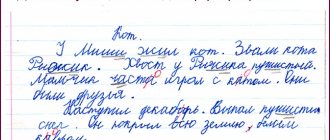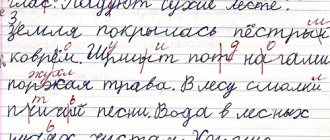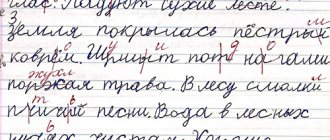Dysorthography is the inability to apply the known rules of the native language in writing. At the same time, the student’s oral speech and intellectual abilities can be at a fairly high level. In some cases, dysorthography is part of the symptoms of such a complex speech disorder as general speech underdevelopment.
It is difficult for a person who cannot competently express his thoughts in writing to achieve success in many areas of professional activity. However, the number of children with this problem is growing from year to year. A child with dysorthography can make up to 80 mistakes in one written work. Moreover, he does not see his mistakes and cannot correct them, although he may know the rules very well. In this case, experts say that the student lacks spelling vigilance.
The essence of the problem and symptoms of speech disorder
Specific skills that help you master the rules of the Russian language:
- rich vocabulary;
- ability to conduct morphological analysis of words;
- ability to choose test words.
The main age category of children suffering from dysorthography are primary and secondary school students, although this speech pathology also occurs in high school.
In addition to morphology, dysorthography suffers from syntax—observance of correct punctuation in writing. When spelling errors in writing become persistent, this leads to chronic failure of the child in many subjects.
Symptoms of the disorder:
- difficulties in mastering terminology, inability to understand and remember what a word, sound, syllable, sentence, verb, adjective, etc. is;
- memorizing spelling rules without understanding their meaning;
- inability to summarize the studied material, draw conclusions, retell the content;
- inability to give an example of a just learned rule and apply it in writing;
- selecting an identical-sounding word to test unstressed vowels, rather than a related word with the same root;
- inability to identify parts of a word: suffix, root, ending, prefix;
- lack or excessive punctuation in sentences.
The manifestation of dysorthography is based on the underdevelopment of mental functions responsible for the formation of specific skills necessary for mastering writing and competent written speech. This is due to the weakening of the child’s health, the consequences of minimal brain dysfunction (MCD) acquired in the prenatal, perinatal period, and in early childhood.
Other reasons for failure to master the rules of the native language:
- a consequence of general speech underdevelopment;
- a consequence of phonetic-phonemic underdevelopment of speech (FFN);
- violation of non-speech mental functions (memory, attention, switching from one type of activity to another, problems with synthesis and analysis);
- a combination of studying a large volume of material with an insufficient rate of development of mental functions;
- inability to master educational material at a fast pace, when errors occur under time pressure and do not occur when working at a slow pace.
In some cases, dysorthography occurs when there seem to be no obvious prerequisites for its occurrence. That is, the child is able to isolate sounds from a word, perform sound-letter analysis, distinguishes complex images, but makes mistakes due to the inability to concentrate, remember and reproduce the text dictated by the teacher.
Dysorphography and ways of its correction. Over the past decades, the number of children experiencing learning difficulties has increased significantly. One of the manifestations of school failure is a persistent violation in the acquisition and use of spelling rules (dysorthography). Successful mastery of spelling knowledge, skills and abilities is the basis for mastering educational programs in various general education subjects. Spellingly correct writing is the most important condition not only for school adaptation, but also for familiarization with the language culture in general. The assimilation of orthographic knowledge, skills and abilities is carried out on the basis of the formation of cognitive prerequisites, especially mental operations of analysis, synthesis, abstraction, and generalization. The most significant prerequisites for mastering orthography, the leading principle of which is the morphological principle, consider the formation of vocabulary (volume of vocabulary, accuracy of understanding and use of words), the grammatical aspect of speech (the ability to inflect and form words, the ability to correctly use various sentence models). In this regard, many scientists associate the problems of poor performance in the Russian language with underdevelopment of oral speech. In modern speech therapy literature, dysorthography is defined as a persistent and specific disorder in the acquisition of orthographic knowledge, abilities and skills of children with ODD. Literary data indicate a close connection between dysgraphic and spelling errors in writing, which are based on a violation of linguistic and cognitive development. Due to the increase in the number of children with written speech disorders and the complication of the structure of speech disorders, the problem of eliminating dysorthography in primary schoolchildren is given an important place in modern speech therapy. The solution to this problem is closely related to the issues of diagnosis and correction of both the phonemic and lexico-grammatical structure of speech in children. Spelling skill, first of all, qualifies as an intellectual and speech skill. A spelling skill is formed on the basis of a whole complex of knowledge and skills, therefore, the interrelation of all components that form the basis of a particular spelling skill is necessary. The formation of spelling skills in ontogenesis is closely related to the development of the child’s cognitive activity. The acquisition of spelling knowledge is a complex cognitive process. Therefore, when mastering spelling, it is necessary to take into account the degree of preservation and functional maturity of the analyzers, the level of inter-analyzer interaction, and the state of oral speech. Various linguistic and psychological factors are considered as prerequisites for children to master spelling patterns: sufficient development of phonemic analysis and synthesis, phonemic representations, clarity of kinesthetic, auditory images of the sound composition of a word, cognitive activity in the field of morphological generalizations, a certain level of development of the lexico-grammatical structure, sufficiently formed motivation , preservation of the processes of memory, thinking, attention. In the psychological and speech therapy literature there are indications of a connection between the level of speech development, especially the acquisition of lexico-grammatical structure, and spelling skills. Many researchers note that schoolchildren with general speech underdevelopment have not developed many speech and non-speech prerequisites for mastering spelling skills or the initial link of the associative chain in the formation of spelling skills. Spelling errors in children with speech pathology are characterized by diversity and persistence. The symptoms and mechanisms of dysorthography are closely related to dysgraphia; both of these disorders of written speech are a manifestation of systemic speech underdevelopment. With normal ontogenesis, students in grades 3-4 experience a qualitative leap in the acquisition of spelling skills, which is associated with the development of lexical and grammatical processes, awareness of morphological patterns in the acquisition of their native language, and with a sufficiently high level of formation of non-speech mental functions. Dysorthography in students in grades 3-4 of a general education school manifests itself in the structure of general speech underdevelopment. The symptoms of dysorthography are polymorphic. The increase in the number of errors among 4th grade students with ODD is due to a number of factors. The number of spelling rules that children have not mastered increases in the 4th grade, since mastery of spelling in the 4th grade is based on the spelling skills learned in the 3rd grade. The number of errors also increases due to the complication of types of written speech (presentation, essay). The complication of the algorithm for implementing spelling rules also leads to an increase in the difficulties of children with dysorthography. The increase in the number of errors is to some extent due to the fact that speech therapy classes in public schools involve mainly the correction of violations of the phonemic principle of writing (dysgraphia) and are not sufficiently aimed at enriching the vocabulary, clarifying and differentiating the meaning of words, working on word formation, and selecting related words , for the correction of agrammatisms, etc. Children with ODD make the largest number of errors when writing rules that obey the morphological principle of writing (spelling unstressed vowels, final consonants, spelling prefixes and prepositions, unpronounceable consonants). The morphological principle of spelling is based both on the theoretical knowledge of students and on practical skills in the field of phonetics, grammar, word formation, semantics, and on a high level of logical thinking, memory, and attention. The main difficulties of children with ODD appear in the following cases: when selecting test words; when mastering morphemic analysis of words; when differentiating prefixes and prepositions; when isolating and differentiating according to the meaning of word-forming and formative morphemes. Many primary schoolchildren with SEN do not know how to formulate spelling rules or use linguistic terms. Moreover, in many cases, children with ODD do not even distinguish the proposed terms in impressive speech. Children with dysorthography exhibit unstable knowledge and skills in determining which part of speech a particular word belongs to, especially when presented with unfamiliar words (rags, redness, disorder, velvety, etc.). The most difficult things for children to identify are adjectives and verbs. Children with speech pathology complete tasks only if the speech therapist introduces the given words into a sentence or suggests the lexical meaning of the words. When performing tasks to master methods for checking spelling, children with dysorthography make a wide range of errors due to their inability to update acquired knowledge and apply the rule in writing. The following problems are typical for children with OHP: children recognize the rule, but cannot remember the method of checking, they select the test word incorrectly (whitewash (whitewash) - squirrel, run, jog; paved - wrinkled). Children with OHP have difficulty finding a spelling pattern based on all three identifying features: inability to correlate the spelling and pronunciation of words; difficulties in finding certain letters and combinations of letters necessary for spell checking; inability to correctly analyze the morphemic structure of a word. Especially great difficulties are observed in children with ODD when identifying related words and finding a common morpheme in words. Thus, when selecting related words for a given root, many children with OHP select words of the same root, but not related ones (nose: wear - spout, gor: gorka - tanned), formed words similar in sound-letter structure (cheat: counted, crying, read, means ). When forming various parts of speech with a given root, children with dysorthography experience great difficulty in forming participles, gerunds, adverbs, almost do not use prefixes, and often form neologisms (frost - freezing, freezing; interest - more interesting, interesting). Some children with OSD also make mistakes when forming the main parts of speech. Children with dysorthography have difficulty identifying morphemes in words, especially prefixes and suffixes. The inability to find a morpheme in words leads to the inability to purposefully search for a spelling, since the student does not know in which part of the word to look for it. In this regard, the student finds it difficult to solve grammatical and spelling problems. Mechanisms of dysorthography. In younger schoolchildren with ODD, the difficulties in mastering spelling knowledge, abilities and skills are based on the following factors: low level of development of the lexical-semantic, morphological, word-formation, syntactic components of language ability, as well as insufficient development of many non-speech mental functions. Junior schoolchildren of the 3rd and 4th grades with dysorthography have a limited volume of lexical units, the semantic structure of the word is not sufficiently formed, the relationship between the elements of the lexical-semantic system is disrupted, and difficulties are noted in updating vocabulary and operating lexical units in the process of generating speech. In this regard, children cannot select or choose the word necessary for testing, form the necessary forms of the word, construct phrases and sentences with the original words. In the structure of word meaning in students with dysorthography, the denotative component predominates over the lexical-semantic one. For example, when explaining the meaning of nouns, children with normal speech development predominantly used paradigmatic connections and lexical-semantic features. At the same time, schoolchildren with speech pathology in most cases indicated denotative features (localization, functions, appearance of the denotation). Schoolchildren in grades 3-4 with dysorthography have a lower level of development of inflection, word formation, and syntactic sentence structure compared to children without dysorthography. Children with ODD have not developed a system of word inflection. Schoolchildren make various grammatical errors, form word forms that do not meet normative criteria, the paradigm of inflection forms is very limited, unstable, with a large number of inflectional mixtures. These children show persistent agrammatism in oral speech, especially when performing special tasks, which manifests itself in the use of only some differential grammatical features, and not the entire set of grammatical meanings necessary for the correct choice of word form. In children with dysorthography, paradigmatic and syntagmatic connections between words are insufficiently formed, both at the semantic and at the formal-sign level. The mistakes of children with dysorthography are caused by the influence of two main trends: the influence of productive forms, as well as the tendency to unify the basis. In children with dysorthography, there is a failure to master many word-formation models, a violation of the formation of morphemic analysis of derivative names, and difficulties in identifying a word-forming morpheme of a certain meaning both at the practical level and at the level of metalinguistic activity. Thus, children learn many derivative words holistically and not discretely. Children with speech pathology do not know the models and rules of word formation, and do not know how to select related words, which is necessary when applying spelling rules. Word formation disorders in children with dysorthography manifest themselves at various levels. The following incorrect strategies have been identified in word formation in children with ODD: I. The use of operations at a different level of linguistic ability (lexical, syntactic) instead of word formation, which was manifested: - in lexical substitutions (a house made of stone - warm, instead of stone) - in the use of phrases instead of derivatives words (instead of a table - a small table); -in replacement by shaping (instead of a knife - legs); II. Violations of the choice of word-forming affix from a certain word-formation paradigm. Errors in choosing a word-forming affix in children with ODD manifested themselves: a) at the semantic level: affixes of a different meaning or non-normative suffixes are used (came in from the bus, the ring is made of gold - golden); b) at the formal symbolic level; unproductive suffixes are replaced by productive ones of the same derivational meaning (koshkin, dog; conductor). This indicates a failure to assimilate the morpheme as the minimum structural element of a word that is correlated with meaning. III. Violation of the choice of the stem of a derived word: incorrect definition of the motivating word, lack of suppletivism (pig). IV. Violations of a morphonological nature, which manifest themselves in distortions of both the base of the motivating word and affixes. As a rule, at the same time there is a disorder in the operations of choosing an affix of a certain meaning (native - rejoice). Errors in word formation in children with dysorthography indicate the systemic nature of word formation disorders, difficulties in mastering the system of word-formation operations and methods of word formation. Schoolchildren with dysorthography also have disorders of coherent speech, both at the semantic level and at the level of the external design of the text. The failure to complete many tasks is based on cognitive difficulties, inability to update knowledge, and a low level of logical and linguistic generalizations. When developing a methodology for speech therapy work for the correction of dysorthography, it is necessary to take into account modern scientific ideas about the psychological structure of the writing process, the process of mastering spelling, the fundamental provisions of special psychology, correctional pedagogy and speech therapy on the principles and patterns of correctional influence, as well as the features of the symptoms and mechanisms of dysorthography identified in the ascertaining experiment for schoolchildren in grades 3-4. The following principles are fundamental for the correction of dysorthography: the position of close interaction in the development of speech and thinking; principle of consistency; gradual formation of mental actions; the principle of a gradual transition from successive to simultaneous processes; formation of metalinguistic activity based on the practical level of language proficiency; the idea of semantics as the leading level of speech activity; formation of spelling skills based on the development of spelling “vigilance”; the principle of “quantization” of a spelling rule; concentric principle of material organization; the principle of taking into account the symptoms and mechanisms of dysorthography. Training is carried out in several areas: 1. Improving the phonetic-phonemic aspect of speech. When implementing this direction, the following tasks were solved: A) Improving the sound pronunciation and sound-syllable structure of the word. B) Development of syllabic analysis and synthesis. C) Work on stress: identifying a stressed syllable and a stressed vowel, differentiating stressed and unstressed vowels in a word. D) Development of phonemic perception (auditory differentiation of voiced and voiceless, hard and soft consonants, affricates and their components, determination of positional alternations). D) Formation of phonemic analysis and synthesis, phonemic representations. 2. Formation of the lexical component of language ability. Within the framework of this direction, the following tasks were implemented: A) Enrichment of the vocabulary in parallel with the expansion of ideas about the surrounding reality, with the study of the school curriculum, especially in the Russian language. B) Consolidation of educational linguistic terminology. C) Formation of the structure of the meaning of a word in the unity of lexical, derivational, grammatical meaning. D) Organization of lexical systematicity and semantic fields. D) Consolidation of paradigmatic and syntagmatic connections of words. 3. Differentiation of the categorical meaning of various parts of speech. In the process of implementing this direction, the following tasks were set and solved: A) Consolidating the categorical meaning of nouns. B) Consolidating the categorical meaning of verbs. C) Consolidating the categorical meaning of adjectives. D) Differentiation of the categorical meaning of different parts of speech. 4. Clarification of the grammatical meaning of words. This direction involved solving the following problems: A) Clarification and differentiation of the grammatical meanings of nouns (number, gender, case, animation, inanimateness, property, common noun). B) Clarification and differentiation of grammatical meanings of adjectives (number, gender, case). C) Clarification and differentiation of grammatical meanings of verbs (present, past, future tense, perfect, imperfect, person, etc.). 5. Formation of morphological generalizations and inflection paradigms. A) Consolidation of the paradigm of nouns based on a set of grammatical meanings. B) Consolidating the paradigm of inflection of adjectives based on the learned paradigm of nouns. C) Consolidating the paradigm of inflection of verbs. 6. The formation of word-formation models-sets and the paradigm of word formation. A) differentiation of the meanings of word -forming affixes of nouns. B) clarification of the meaning of word-forming models-sets and the paradigm of the word formation of nouns. C) differentiation of the meanings of word -forming affixes of adjectives. D) clarification of the meaning of word-forming models-sets and the paradigm of the word formation of the names of adjectives. E) differentiation of the meanings of the word -forming affixes of verbs. F) clarification of the meaning of word-forming models-sets and the paradigm of the word formation of verbs. G) consolidation of the paradigm of the word formation of nouns, adjectives and verbs. 7. Differentiation of related words. Within the framework of this direction, the tasks were set: a) the definition of the general lexical meaning of related words. B) the definition of differences in the meaning of related words. C) the definition of general and different in the sound structure of related words. D) comparison by meaning and sound of related words. 8. The development of morphemic and morphological analysis. When implementing this direction, the following tasks were solved: a) the allocation of the root morpheme from words. B) the allocation of general suffixes from a number of words. C) the allocation of general prefixes from a number of words. D) determination of the morphemic composition of the word. E) the definition of morphological criteria of the form of the word (morphological analysis). 9. The formation of a syntactic component of language ability. The tasks were the following: a) the formation of a syntactic structure of a simple and complex sentence at a practical level. B) determination of the nature of the sentence and the syntactic functions of its members in the process of metered activity. 10. The formation of spelling vigilance, spelling knowledge, skills. A) consolidation of knowledge of spelling rules. B) consolidation of algorithms for applying spelling rules. 11. The development of cognitive activity. A) the development of attention. B) the development of memory. C) the development of linguistic thinking: the ability to analyze, synthesis, comparison, generalization on language material, classification operations and series based on various linguistic criteria. 12. The assimilation of the relationship of phonemic, morphological, syntactic, word -formation competence and spelling knowledge. The implementation of these areas in the system of speech therapy work is carried out sequentially, taking into account the close relationship of various subsystems of the language, the stages of the formation of spelling actions, the level of formation of spelling knowledge, skills. For each of the directions, the stages, content and methods of speech therapy exposure are determined, speech material is represented. Speech therapy work on the correction of dyserphography includes 3 stages. At the first stage, the main attention is paid to the formation of psychological prerequisites (motivation, attention, memory, control), as well as speech prerequisites for spelling activity (correction of oral speech, dysgraphia, the formation of linguistic ability at a practical level). At the second stage, the formation of lexical, morphological, syntactic operations in specially selected exercises and tasks in oral and written speech, and the assimilation of the most easy spelling by children is carried out. Speech therapy work at the third stage is aimed at integrating phonemic, lexical, morphological, word -formation operations, the formation of an algorithm of spelling activity, and the assimilation of complex spelling. In the process of speech therapy work on the correction of dyserphography, the thematic planning of classes for students of grade 3 and 4 with dyserphography is determined, taking into account the school curriculum and the stage of correction of dyserphography. Mastering spelling rules and their implementation is based on the principle of “quantization”. For each rule, the “quanta” system, the necessary speech prerequisites, as well as an algorithm of speech actions, is defined. At all stages, work is carried out on the normalization of visual and verbal memory, attention, the development of linguistic thinking in solving spelling problems. The system of speech therapy work on the correction of dyserphography in younger schoolchildren with OHP is effective. On this topic, the following works have been published: 1. Azova O. I. On the prevention of reading and writing disorders. /O.I. Azov // Collection of theses of Moscow Pedagogical Readings. - M .: 1996. -S. 120-122. - 0.3 pp. 2. Azov O. I. Disorders of written speech. /O.I. Azova, E.V. Oganesyan, M.A. Lobov, I.A. Kachkov, M.F. Makarenko // Bulletin of Practical Neurology. - 1998. - No. 3. - S. 258 - 263. - 0.5 pp. (The author belongs to 0.1p.p.) 3. Azova O. I. Disorders of written speech./ O.I. Azov // Collection of works of young scientists of the Moscow State Pedagogical University. Issue 2. - M .: 1998. - S. 117 - 131. - 0.8 pp. 4. Azova O. I. Development of linguistic flair. /O.I. Azov // Actual problems of special pedagogy and special psychology: a collection of theses of Moscow pedagogical readings. - M .: 1999. - S. 83 - 85. - 0.1 pp. 5. Azova O. I. Disorphography among younger schoolchildren of a comprehensive school. /O.I. Azov // V of Tsarskoye Selo Readings: Materials of the International Scientific and Practical Conference. - St. Petersburg: LGOU named after A.S. Pushkin, 2001. - P.3 - 4. - 0.3 pp. 6. Azova O. I. Features of mastering spelling younger students with general speech underdevelopment (level IV). /O.I. Azov // VI Tsarskoye Selo Readings. Materials of the International Scientific and Practical Conference. - St. Petersburg: LGOU named after A.S. Pushkin, 2002. - S.97. –0.1 pp. 7. Azova O. I. Features of the work on the correction of dyserphography in younger students with general speech underdevelopment (IV level). /O.I. Azov // VI Tsarskoye Selo Readings. Materials of the International Scientific and Practical Conference. - St. Petersburg: LGOU named after A.S. Pushkin, 2002. - S.67. –0.1 pp. 8. Azova O. I. The difficulties of mastering written speech in children with general speech underdevelopment (IV level). /O.I. Azov // All-Russian Scientific Conference dedicated to the 70th anniversary of the KGPU: a collection of scientific materials. -Krasnoyarsk, 2002. -S. 132 -133. –0.1 pp. 9. Azova O. I. Development of spelling skills among younger schoolchildren with OHP (IV level). / Azova O.I. // Speech therapy: methodological traditions and innovation / Ed. S.N. Shakhovskaya, T.V. Volosovets. -Moscow-Voronezh, 2003.-S. 206-215. - 0.9 pp. 10. Azova O. I. Features of mastering spelling by younger students with the general underdevelopment of speech. /O.I. Azov // Study of violations of writing and reading. Results and prospects. Materials of the I International Conference of the Russian Association of Dyslexia. -M.: Publishing House of the Moscow Social and Humanitarian Institute. -2004. -S. 14 -19. - 0.5 pp. 11. Azova O. I. Methods of work on the correction of dyserphography based on the use of the principle of "quantization". /O.I. Azov // Materials of the All-Russian Scientific and Practical Conference on the problems of special education. April 25-26, 2005 St. Petersburg: Lying to them. A.S. Pushkin, 2005. P.3-6. - 0.3 pp. 12. Azova O. I. Scientific and theoretical foundations of the correction of dyserphography in children with general speech underdevelopment. /R.I. Lalaeva, O.I. Azov // Materials of the All-Russian Scientific and Practical Conference on the problems of special education. April 25-26, 2005 St. Petersburg: Lying to them. A.S. Pushkin, 2005. P.156-159. - 0.3 pp. (The author owns 0.15 pp). 13. Azova O. I. Speech therapy work on the correction of dyserphography (on the example of work with an unstressed vowel in the root). /O.I. Azov // Practical Psychology and speech therapy. -2005.-No. 4.-S. 34-37. - 0.4 pp. 14. Azova O. I. Speech therapy work on the correction of dyserphography among younger students. /O.I. Azov // Practical Psychology and speech therapy. -2005.-No. 5-6. -S. 22-32. - 1 p.L. 15. Azova O. I. Using the principle of quantification of spelling rules in the process of correction of dyserphography. /O.I. Azov // Children with development problems. - 2006.- No. 1.- p.16-18.- 0.3 pp. 16. Azova O. I. Differential diagnosis of dyorphography in younger students. / R.I. Lalaeva, O.I. Azov // School Speech therapist. -2005.-No. 5-6 (8-9). -P.12-21. - 1 p.L. (The author belongs to 0.5 pp). 17. Azova O. I. System of speech therapy work on the correction of dyserphography in younger students. Author for the degree of candidate of pedagogical sciences, M., 2006 18. Azov O. I. Directions and methods of speech therapy work to eliminate dyserphography (article) School speech therapist. -2010.-No. 5-6. -P.12-21. 19. Azova O. I. Description of Disorphography in children with ONR (theses) Materials of the conference of students and young scientists: abstracts. April 2010. - M.: MPSI, 2010 - 179 p. 20. Azova O. I. Disorphography - the actual issue of speech therapy (article). Materials of the international theoretical and methodological seminar “Special pedagogy and special psychology: modern problems of theory, history, methodology”. April 2010-M.: MGPU, 2010-281 21. Azova O. I. Logopedic work on the correction of dyserphography among younger students with general speech underdevelopment (educational and methodological manual). Educational and methodological manual. - M.: RUDN, 2007 .-- 83 p. 22. Azova O. I. An examination of younger schoolchildren with dyserphography (training manual). Educational and methodological manual. Part 1. - M.: RUDN, 2007. - 53 p. 23. Azova O. I. An examination of younger schoolchildren with dyserphography (training manual). Educational and methodological manual. Part 2. - M.: RUDN, 2007. - 47 p. 24. Azova O. I. Diagnostic kit. Speech therapy examination of primary schoolchildren (training manual). M.: Sphere, 2008 .-- 48 p.
Types of dysorthography
There are several degrees of speech pathology. They depend on the difficulties students overcome, on the type of spelling in which they make the greatest number of errors:
- This group contains errors in spelling of a high degree of difficulty - paired and double consonants, an unstressed vowel at the root, an unpronounceable consonant.
- The second group contains spelling spellings of moderate severity - unverifiable words, capital letters in first names and patronymics, in the names of geographical objects.
- The third group contains easy spellings - indicating the softness of consonants in writing.
Methods for correcting the disorder
Usually, adults attribute a child’s poor performance to laziness and lack of diligence; parents turn to specialists too late.
Since speech disorders are based on underdevelopment of mental processes, it is better when several specialists are involved in correcting the defect:
- speech therapist;
- psychologist.
With the transition to the 3rd–4th grade, children are offered more complex types of activities to master their native language (composition, presentation), so the number of errors in schoolchildren with dysorthography increases many times, which leads to a drop in academic performance and low grades in the diary.
To facilitate the acquisition of spelling rules, children are offered a system of sequential grammatical actions, each of which is reinforced separately. Only after firmly mastering one operation do they move on to the next stage. The teacher is not limited to one type of training; in parallel, he uses grammatical generalizations to create a stable system of his native language.
Examples of exercises offered in speech therapist classes:
- choose adjectives for the noun (domestic bird, bright, gray, fast, shy; the sea is blue, calm, warm, salty, endless);
- select nouns for the verb (snow is falling, leaves, vase, stone, ball) and vice versa (the lemon is ripe, the apple is ripe, the plum is ripe, the fruit is ripe);
- find all the words with the same root in the picture (forester, timber carrier, forest belt, forest);
- guess the picture and explain the guessed expression (“nod off”);
- collect objects in pairs, choose a generalizing word for them (elephant-zebra animals of hot countries, question who?);
- combine words into phrases;
- name an object, knowing its parts (beak, legs, wings - bird (who?);
- name the required noun by analogy (uncle and ... aunt, son and ... daughter);
- name the place of work (cook - kitchen, doctor - hospital) or the necessary tool (scissors - hairdresser, brush - painter);
- write as many words as possible with the same vowels, for example, “O” (crow, gold, good, etc.);
- encrypt the stressed vowel in a word with schemes;
- arrange the pictures under gender symbols (cat - masculine, cow - feminine, sun - neuter);
- form an adjective from a noun (a gold ring is golden, but not golden, plum jam is plum, not plum or creamy).
At the same time, work is being done to develop memory, attention, thinking, and imagination. Specialists teach children self-control skills, improve oral speech, and the ability to act according to a certain algorithm.
The video below provides an example of how this can be done:
Causes
Dysorphography in younger schoolchildren can manifest itself in isolation as an independent defect or in the structure of a complex disorder of several components of speech. The following factors underlie this speech disorder:
- low level of formation of the lexical-semantic, grammatical, syntactic aspects of speech;
- insufficient development of non-speech mental functions;
- unpreparedness for school.
Another reason for the occurrence of dysorthography is the immaturity of the language “sense,” in other words, the lack of a sense of language, which actively develops in preschool age.
Most errors are related to the principles of morphological analysis (spelling of unstressed vowels and unpronounceable consonants at the root of a word, consonants at the end of a word, combined and separate spelling of prefixes and prepositions). It is known that the morphological principle of spelling is based on the theoretical knowledge of students, and on their practical skills in the field of phonetics, grammar, word formation, semantics, as well as on their high level of analytical-synthetic activity, memory, and attention.
Tips for parents
The main thing that parents can do for their child is to create a favorable psychological climate for him during correctional work. The schoolchild is already under the pressure of the situation, and his mood is often not the most rosy, and then adults traumatize the child by constantly pointing out his speech errors.
The consequence of this may be that the child will become withdrawn, and instead of the communication he so needs, speech will slow down its development, will not improve and be enriched, which will lead to problems of social adaptation in the team. Therefore, it is important to show patience and forbearance to resolve the situation successfully.









